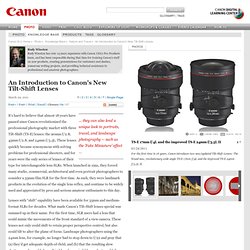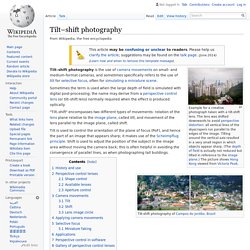

Digital Learning Center - An Introduction to Canon’s New Tilt-Shift Lenses. ... they can also lend a unique look to portraits, travel, and landscape photography -- such as the 'Fake Miniature' effect … It’s hard to believe that almost 18 years have passed since Canon revolutionized the professional photography market with three Tilt-Shift (TS-E) lenses: the 90mm f/2.8, 45mm f/2.8, and 24mm f/3.5L.

These lenses quickly became synonymous with solving problems for professional shooters, and for years were the only series of lenses of their type for interchangeable lens SLRs. When launched in 1991, they forced many studio, commercial, architectural and even portrait photographers to consider a 35mm film SLR for the first time. As such, they were landmark products in the evolution of the single lens reflex, and continue to be widely used and appreciated by pros and serious amateur enthusiasts to this day.
Lenses with “shift” capability have been available for 35mm and medium-format SLRs for decades. Tilt-shift photography. Tilt–shift photography is the use of camera movements on small- and medium-format cameras, and sometimes specifically refers to the use of tilt for selective focus, often for simulating a miniature scene.

Sometimes the term is used when the large depth of field is simulated with digital post-processing; the name may derive from a perspective control lens (or tilt–shift lens) normally required when the effect is produced optically. Tilt is used to control the orientation of the plane of focus (PoF), and hence the part of an image that appears sharp; it makes use of the Scheimpflug principle. Shift is used to adjust the position of the subject in the image area without moving the camera back; this is often helpful in avoiding the convergence of parallel lines, as when photographing tall buildings. The Little Things on Photography Served.